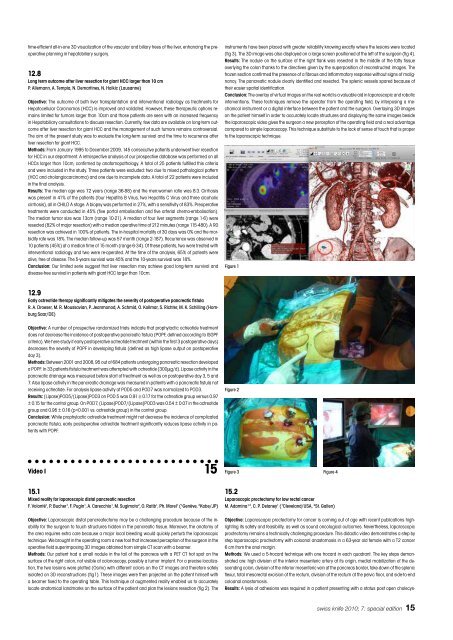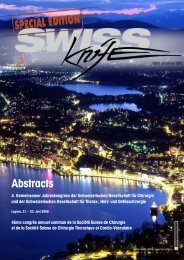Anorectal Manometry in 3D NEW! - Swiss-knife.org
Anorectal Manometry in 3D NEW! - Swiss-knife.org
Anorectal Manometry in 3D NEW! - Swiss-knife.org
You also want an ePaper? Increase the reach of your titles
YUMPU automatically turns print PDFs into web optimized ePapers that Google loves.
time-efficient all-<strong>in</strong>-one <strong>3D</strong> visualization of the vascular and biliary trees of the liver, enhanc<strong>in</strong>g the preoperative<br />
plann<strong>in</strong>g <strong>in</strong> hepatobiliary surgery.<br />
12.8<br />
Long term outcome after liver resection for giant HCC larger than 10 cm<br />
P. Allemann, A. Tempia, N. Demart<strong>in</strong>es, N. Halkic (Lausanne)<br />
Objective: The outcome of both liver transplantation and <strong>in</strong>terventional radiology as treatments for<br />
Hepatocellular Carc<strong>in</strong>omas (HCC) is improved and validated. However, these therapeutic options rema<strong>in</strong>s<br />
limited for tumors larger than 10cm and those patients are seen with an <strong>in</strong>creased frequency<br />
<strong>in</strong> Hepatobiliary consultations to discuss resection. Currently, few data are available on long-term outcome<br />
after liver resection for giant HCC and the management of such tumors rema<strong>in</strong>s controversial.<br />
The aim of the present study was to evaluate the long-term survival and the time to recurrence after<br />
liver resection for giant HCC.<br />
Methods: From January 1995 to December 2009, 145 consecutive patients underwent liver resection<br />
for HCC <strong>in</strong> our department. A retrospective analysis of our prospective database was performed on all<br />
HCCs larger than 10cm, confirmed by anatomopathology. A total of 25 patients fulfilled this criteria<br />
and were <strong>in</strong>cluded <strong>in</strong> the study. Three patients were excluded: two due to mixed pathological pattern<br />
(HCC and cholangiocarc<strong>in</strong>oma) and one due to <strong>in</strong>complete data. A total of 22 patients were <strong>in</strong>cluded<br />
<strong>in</strong> the f<strong>in</strong>al analysis.<br />
Results: The median age was 72 years (range 36-88) and the men:women ratio was 8:3. Cirrhosis<br />
was present <strong>in</strong> 41% of the patients (four Hepatitis B Virus, two Hepatitis C Virus and three alcoholic<br />
cirrhosis), all <strong>in</strong> CHILD A stage. A biopsy was performed <strong>in</strong> 27%, with a sensitivity of 83%. Preoperative<br />
treatments were conducted <strong>in</strong> 45% (five portal embolisation and five arterial chemo-embolisation).<br />
The median tumor size was 13cm (range 10-21). A median of four liver segments (range 1-6) were<br />
resected (82% of major resection) with a median operative time of 212 m<strong>in</strong>utes (range 115-480). A R0<br />
resection was achieved <strong>in</strong> 100% of patients. The <strong>in</strong>-hospital mortality at 30 days was 0% and the morbidity<br />
rate was 18%. The median follow-up was 57 month (range 2-187). Recurrence was observed <strong>in</strong><br />
10 patients (45%) at a median time of 15 month (range 6-34). Of these patients, two were treated with<br />
<strong>in</strong>terventional radiology and two were re-operated. At the time of the analysis, 65% of patients were<br />
alive, free of disease. The 5-years survival was 45% and the 10-years survival was 18%.<br />
Conclusion: Our limited serie suggest that liver resection may achieve good long-term survival and<br />
disease-free survival <strong>in</strong> patients with giant HCC larger than 10cm.<br />
12.9<br />
Early octreotide therapy significantly mitigates the severity of postoperative pancreatic fistula<br />
R. A. Droeser, M. R. Moussavian, P. Jeanmonod, A. Schmid, O. Kollmar, S. Richter, M. K. Schill<strong>in</strong>g (Homburg<br />
Saar/DE)<br />
Objective: A number of prospective randomized trials <strong>in</strong>dicate that prophylactic octreotide treatment<br />
does not decrease the <strong>in</strong>cidence of postoperative pancreatic fistula (POPF, def<strong>in</strong>ed accord<strong>in</strong>g to ISGPF<br />
criteria). We here study if early postoperative octreotide treatment (with<strong>in</strong> the first 3 postoperative days)<br />
decreases the severity of POPF <strong>in</strong> develop<strong>in</strong>g fistula (def<strong>in</strong>ed as high lipase output on postoperative<br />
day 3).<br />
Methods: Between 2001 and 2008, 95 out of 684 patients undergo<strong>in</strong>g pancreatic resection developed<br />
a POPF. In 33 patients fistula treatment was attempted with octreotide (300μg/d). Lipase activity <strong>in</strong> the<br />
pancreatic dra<strong>in</strong>age was measured before start of treatment as well as on postoperative day 3, 5 and<br />
7. Also lipase activity <strong>in</strong> the pancreatic dra<strong>in</strong>age was measured <strong>in</strong> patients with a pancreatic fistula not<br />
receiv<strong>in</strong>g octreotide. For analysis lipase activity at POD5 and POD7 was normalized to POD3.<br />
Results: [Lipase]POD5/[Lipase]POD3 on POD 5 was 0.91 ± 0.17 for the octreotide group versus 0.97<br />
± 0.15 for the control group. On POD7, [Lipase]POD7/[Lipase]POD3 was 0.54 ± 0.07 <strong>in</strong> the octreotide<br />
group and 0.95 ± 0.16 (p
















